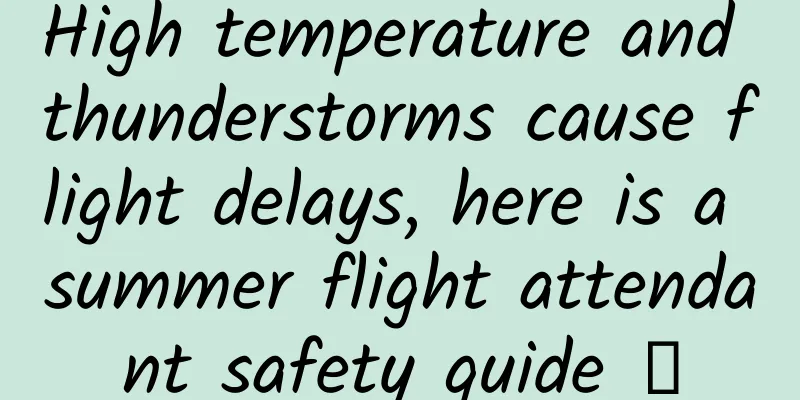High temperature and thunderstorms cause flight delays, here is a summer flight attendant safety guide →

|
Since the beginning of summer, many areas in northern my country have suffered from scorching hot weather. At the same time, the south has been experiencing long-term rainy and cloudy weather with frequent thunderstorms. This not only brings a lot of inconvenience to people's production activities, but also affects travel safety. High temperature and lightning are the most common and most difficult problems encountered by aviation in summer. Recently, many friends around me have encountered flight cancellations or delays due to thunderstorms. Why do high temperatures and lightning affect flight takeoffs and landings? How can we prevent them? Copyright images in the gallery. Reprinting and using them may lead to copyright disputes. 1. Are you afraid of heat? Airplanes are also afraid of heat! The biggest threats facing aircraft in hot weather are insufficient lift and structural thermal stress problems caused by high temperatures . As we all know, an airplane must have enough lift to fly, and the lift of an airplane is proportional to the air density , that is, the greater the air density, the greater the lift . Under standard atmospheric pressure, when the temperature reaches 50°C , the surface air becomes thinner due to expansion, and the density will be nearly 10% lower than at 20°C . In other words, as the temperature rises, the lift of the airplane will decrease, and it may even affect the safety of takeoff and landing. Of course, there is still a question that needs to be discussed here: airplanes often cruise at altitudes of nearly 10,000 meters, where the air density is much lower than that of the air on the surface. Why do airplanes still have enough lift to maintain flight? Copyright images in the gallery. Reprinting and using them may lead to copyright disputes. This involves the relationship between lift and flight speed , that is, lift is proportional to the square of speed . The cruising speed of an aircraft at high altitude is usually above 800 km /h , and it can still obtain great lift even in thin air conditions. When taking off and landing, the speed of the aircraft is often only 200~300 km / h . The decrease in speed will inevitably lead to a decrease in lift. At this time, if the high temperature weather causes the air density to decrease, it will undoubtedly make the situation worse. In addition to reducing lift, high temperatures can also have an adverse effect on the structural safety of aircraft. The most commonly used structural materials on aircraft are metal materials such as aluminum alloys . Although their manufacturing and assembly processes are very mature, their strength will decrease sharply as the temperature rises. Moreover, since the expansion of various parts of the fuselage at high temperatures is different, they will form constraints on each other, causing new stress distribution inside the structure, causing the structure to twist and deform , thus posing a safety hazard. In the face of high temperatures, in addition to grounding flights, the following countermeasures can also be adopted: First, reduce the number of passengers and cargo on the plane to reduce the weight of the aircraft and compensate for the loss of lift; second, since the temperature at night is lower than during the day, flights can be adjusted to night time , which is also a common practice at many airports in low-latitude areas; third, extend the runway to allow the aircraft to achieve a greater take-off speed. Copyright images in the gallery. Reprinting and using them may lead to copyright disputes. 2. Lightning is coming? Airplane: I'll hide! Lightning usually occurs in cumulonimbus clouds in the troposphere , while large passenger aircraft mostly fly in the stratosphere . In other words, there is no need to worry about lightning when an aircraft is cruising in the stratosphere. However, aircraft have to cross the troposphere during takeoff and landing , which makes it inevitable that they may encounter lightning. According to statistics, there are 8 million lightning strikes around the world every day, and an aircraft on a fixed route will be struck by lightning once a year on average[1]. The most obvious manifestation of damage caused by lightning to an aircraft is burning, melting and structural deformation. When lightning current flows through the fuselage of an aircraft, it can transmit huge energy within a few microseconds, causing the material to melt or vaporize, and instantly damaging or distorting the aircraft structure. In addition to visible damage, lightning often forms a changing magnetic field around the aircraft, generating induced voltage and current in the aircraft's internal circuits. Modern aircraft are generally equipped with advanced electronic and electrical equipment such as flight control systems, and in order to reduce costs and weight, aircraft components are increasingly made of fiber-reinforced composite materials. Among them, electronic and electrical equipment are strongly affected by the electromagnetic environment, and composite materials, because their conductivity is much lower than that of metals, can not only absorb more energy, but also have extremely limited electromagnetic shielding capabilities, making them more sensitive to lightning environments. All of these seriously threaten flight safety. Copyright images in the gallery. Reprinting and using them may lead to copyright disputes. The most effective way to deal with lightning is to hide. The weather radar on the aircraft can survey the flight environment in real time, and the weather forecast from the ground can also help pilots obtain weather information, so that the aircraft can stay away from areas with severe thunderstorms as much as possible. However, even if you encounter lightning head-on, you don't have to worry too much, because the current advanced civil airliners will be designed for lightning protection at the beginning of development to ensure the safety of the aircraft and onboard equipment. In the design of lightning protection, the fuel tank is undoubtedly the top priority. In order to avoid the combustion and explosion of the fuel tank, the fuel system is placed in an area where the probability of direct attachment of the discharge arc is very low. The fuel tank and its internal parts that may be charged are also designed as low-impedance paths. In this way, the heat generated by the lightning current when passing through will not be too large, and it is not easy to form electric sparks between the gaps between the components. Similarly, the aircraft frames and between the skin and the structure are also designed as low-impedance paths. In addition, lightning protection strips are commonly installed on aircraft. When the aircraft is parked on the apron, the lightning protection strips on the aircraft will be connected to the ground. Once the aircraft is struck by lightning, the lightning protection strips can conduct the lightning current to the ground. The vertical stabilizer, wing tips and other protruding parts of the aircraft are equipped with discharge brushes, which can also instantly release the current flowing through to the outside of the fuselage. In recent years, an interesting study has shown that "charging" an aircraft can also reduce its risk of being struck by lightning. Scientists have found that before being struck by lightning, charged clouds will first polarize the surface of the fuselage, causing one side of the aircraft to carry more positive charges and the other side to carry more negative charges, thus forming a bidirectional current. It is this current that makes the aircraft vulnerable to lightning strikes. Therefore, the researchers did the opposite and installed a charging system on the aircraft, which can sense the electric field of the fuselage and its surroundings through sensors, and will promptly charge the reverse charge before the electric field reaches the critical value for lightning strikes, thereby strangling the bidirectional current of the fuselage in the cradle. 3. Tips for safe flying in summer Modern aircraft have very sophisticated technology to protect against high temperatures and lightning. Passengers do not need to panic when they encounter high temperatures or lightning strikes. Here are some tips for flying in summer: (1) Summer mornings are relatively cool, and thunderstorms mostly occur in the afternoon and rarely in the morning. Therefore, morning flights are usually less affected by high temperatures or thunderstorms. It is recommended that you take morning flights whenever possible. (2) Pay close attention to weather conditions and flight status near the airport. If you encounter abnormally high temperatures or thunderstorms, your flight is likely to be delayed or even cancelled. Take precautions against heatstroke on the way to the airport. In thunderstorms, try to take the subway or other means of transportation to reduce ground travel. (3) Extreme weather in summer may cause the aircraft to face more turbulent air currents and headwinds during flight. When the aircraft experiences severe turbulence, be sure to fasten your seat belt and hold the handrails tightly. References: [1] Duan Zemin. Overview of aircraft lightning protection[J]. High Voltage Engineering, 2017, 43(5): 1393-1399. Author: Zhu Lei, PhD in Aerospace Propulsion Theory and Engineering, Nanjing University of Aeronautics and Astronautics Reviewer: Deng Xiaotao, Senior Engineer, AECC Hunan Power Machinery Research Institute Produced by: Science Popularization China Produced by: China Science and Technology Press Co., Ltd., China Science and Technology Publishing House (Beijing) Digital Media Co., Ltd. |
>>: The mortality rate is extremely high! This bacteria can "eat meat", so be careful in summer!
Recommend
Wi-Fi Master Key: How to crack it and whether it is dangerous
Why can this "key" crack Wi-Fi? Does it...
iPhone X's Face ID has a bug, Apple's internal document reveals the truth
Face ID is one of the biggest highlights of iPhon...
Layoffs and bankruptcies: German auto parts manufacturers face unprecedented crisis, and their hopes of rising again are in vain
When a whale falls, everything comes to life. But...
300 JD Experience Stores point the way for the industry How will the fourth retail revolution reshape the market landscape
With the continuous improvement of technology, th...
Hardcore Media-Product Selection Course [What Products Bring Their Own Traffic]
Hardcore Media - Product Selection Course [What Pr...
Where do your nasal and throat swab samples go? One picture to understand!
Editor-in-charge|Zhai Qiaohong Editor|Jiang Yue S...
That's not a bug, it's a new requirement
Ever since I started working in software developm...
Four obstacles shatter the 5G counterattack dreams of small and medium-sized manufacturers
Smartphone sales in the first quarter were dismal...
How can a promotion account achieve the best delivery effect? Here are 8 tips
Have you ever encountered this situation? You too...
National Low Carbon Day | Geological Hydrogen: A Green Energy Treasure Hidden Deep Underground
Today is National Low Carbon Day. With the rapid ...
What will be the hottest thing in 2016?
[[161131]] 2016 has arrived. I wonder if you have...
Mate7 is popular, so Huawei's problem comes
It is no exaggeration to say that the emergence o...
Faith and the Cage, a documentary about Steve Jobs
[[149041]] “A churchman without empathy” That’s w...
Scientists discover that plants can actually "talk"?
Poplar leaves rustle when wind blows through them...









